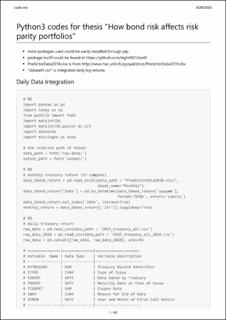| dc.contributor.author | Shi, Qingqi | |
| dc.contributor.author | Zhang, Lian Zhang | |
| dc.date.accessioned | 2020-11-12T13:59:52Z | |
| dc.date.available | 2020-11-12T13:59:52Z | |
| dc.date.issued | 2020 | |
| dc.identifier.uri | https://hdl.handle.net/11250/2687647 | |
| dc.description | Masteroppgave(MSc) in Master of Science in Finance - Handelshøyskolen BI, 2020/Masteroppgave(MSc) in Master of Science in Quantitative Finance - Handelshøyskolen BI, 2020 | en_US |
| dc.description.abstract | We document the performance of risk parity portfolios (RPP) of
U.S. equities and government bonds over more than fty years of
daily and monthly data. RPP's strong outperformance compared
to 60/40 portfolios has to some extent relied on sub-periods of
falling interests rates. RPP have a large tail risk materializing in
periods of sharply rising interest rates together with recession or
stag
ation. In these situations, positive return correlation together
with rising rates have a very negative impact on both RPP and
60/40 portfolios, with RPP su ering the larger tail loss. We also
analyze how volatility variation of equities and bonds a ect RPP's
volatility theoretically and empirically.
Keywords: Risk parity portfolio, Government bond, Government
bond yield, volatility variation | en_US |
| dc.language.iso | eng | en_US |
| dc.publisher | Handelshøyskolen BI | en_US |
| dc.subject | quantitative finance | en_US |
| dc.subject | finance | en_US |
| dc.subject | finans | en_US |
| dc.subject | financial economics | en_US |
| dc.title | How bond risk affects risk parity portfolios | en_US |
| dc.type | Master thesis | en_US |

